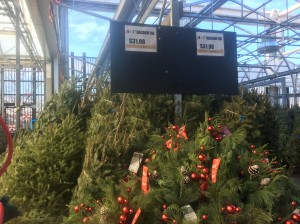I started blogging in 2006 when I became director of IRIS. Since returning to being a full-time Biology professor, after doing my 7 years as an administrator, I've incorporated blogging assignments into my teaching. I find that both blogging, and using social media are great ways for students (and professors) to practice writing.
In 2014, I contributed three posts to the inventive #AdventBotany blog run by Dr. Alastair Culham and Dr. Jonathan Mitchley at Reading University: Amaryllis, Red-Osier Dogwood, and Poinsettia. This was a fun writing challenge, that was very different from writing journal articles and lectures.
I enjoyed it so much, that the other week, I got in touch with Jonathan and Alastair to ask if they planned a new 2015 Advent Botany series, and whether they would consider broadening the contributors to include other plant ecologists and botanists on twitter. They said "yes", so I offered 4 posts. You can read them below in various stages of development.
@jvamosi, I 'spect @BotanyRNG & @drmgoeswild welcome all help with 24 new #AdventBotany posts cc @tnanps @rbg_science @TBG_Canada @BitKblog
— Dawn Bazely (@dawnbazely) November 14, 2015
The first post went up on December 1st and you can compare my version with Alastair's. He made some different choices of image and placement.
Advent Botany 2015 post 1: Balsam Fir: one of the most popular Christmas tree in Canada -- I knew from last year that I wanted to write about Canadian conifers that are used as Christmas decorations, so I keep a look out for possible photos to include
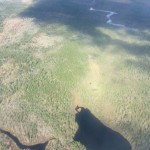 Much of Canada’s landmass is dominated by the boreal forest ecosystem. The characteristic tree species of the boreal biome are conifers such as pines, firs and spruces. Another boreal evergreen species, white cedar, has a range that extends further south, and it's common in the Great Lakes-St. Lawrence Region to the south of the boreal.
Much of Canada’s landmass is dominated by the boreal forest ecosystem. The characteristic tree species of the boreal biome are conifers such as pines, firs and spruces. Another boreal evergreen species, white cedar, has a range that extends further south, and it's common in the Great Lakes-St. Lawrence Region to the south of the boreal.
In the United Kingdom, traditional Christmas greenery includes holly and ivy, but in Canada and the northeastern USA, balsam fir, eastern white cedar and red and white pine are very popular in Christmas decorations (right). Many Canadian homes have real, rather than fake greenery in them over the holiday season.
In Canada, balsam fir (Abies balsamea), which also makes excellent wreaths, is one of the most popular species of Christmas tree. Lauren, who works at Toronto Parks' historic Colborne Lodge, built in 1837 by John Howard, can be seen at right, below, with a traditional balsam fir wreath on the front door, and inside (left, below), with a balsam fir Christmas tree. Those are real candles on the tree, for which the decorative style is intended to evoke a Victorian Christmas.

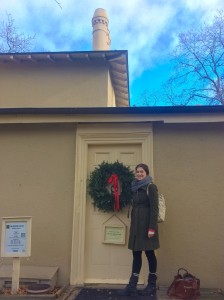 John Howard, one of Toronto’s first architects, engineers, and surveyors, acquired the land, which is now High Park, Toronto, and it was never actually farmed or built upon. His home, Colborne Lodge, a regency-style cottage, contains much of the original furniture that John Howard built. It’s open to the public and is decorated in Victorian holiday style for the seasons. My favourite fact about Colborne Lodge is that it had the first indoor toilet in the City of Toronto!
John Howard, one of Toronto’s first architects, engineers, and surveyors, acquired the land, which is now High Park, Toronto, and it was never actually farmed or built upon. His home, Colborne Lodge, a regency-style cottage, contains much of the original furniture that John Howard built. It’s open to the public and is decorated in Victorian holiday style for the seasons. My favourite fact about Colborne Lodge is that it had the first indoor toilet in the City of Toronto!
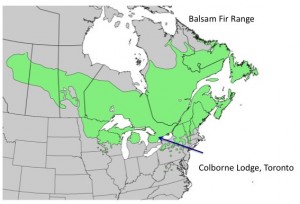 Balsam fir has a wide range from Alberta in the west, across to eastern Canada and the USA (range map, below, adapted from Wikimedia: Elbert L. Little, Jr., U.S. Department of Agriculture, Forest Service). While cutting a tree from the local wood lot is still popular, these days, most trees are grown on Christmas tree farms. While you can buy them pre-cut, many families also head out to cut their own tree from a tree farm.
Balsam fir has a wide range from Alberta in the west, across to eastern Canada and the USA (range map, below, adapted from Wikimedia: Elbert L. Little, Jr., U.S. Department of Agriculture, Forest Service). While cutting a tree from the local wood lot is still popular, these days, most trees are grown on Christmas tree farms. While you can buy them pre-cut, many families also head out to cut their own tree from a tree farm.
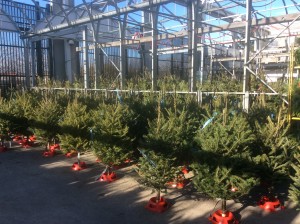 In addition to its popularity for Christmas decorations, balsam fir is also the source of resin, which oozes from blisters on the trunk. This sticky resin has many uses, including for mounting specimens for microscopy! Though, I understand that mostly synthetic resins are used these day. I can personally attest to the fact that resin on the hands and clothing is tough to get off, so my advice is, if you want to hug a tree, make it something other than a balsam fir!
In addition to its popularity for Christmas decorations, balsam fir is also the source of resin, which oozes from blisters on the trunk. This sticky resin has many uses, including for mounting specimens for microscopy! Though, I understand that mostly synthetic resins are used these day. I can personally attest to the fact that resin on the hands and clothing is tough to get off, so my advice is, if you want to hug a tree, make it something other than a balsam fir!
Advent Botany 2015 post 2: White Cedar is best for garlands -- since white cedar is such an important species in Ontario, I went totally overboard with this post
Eastern white cedar (Thuja occidentalis) is popular for use in garlands and ropes used for door and window decorations during the Christmas holiday season in Canada. White cedar fronds are floppy, with scaly leaves rather than needles, so it’s not very good as a Christmas tree. My friend, Joanne, owner of Willem and Jools florist in Toronto, is holding a cedar garland at left.

 White cedar would have been used to decorate Colborne Lodge when John and Jemima Howard lived there during the 1800s (near right). Because live and cut plants have a place everywhere in the world, it also fits in well with trendy shops, like Grateful Head, one of Toronto's hippest hairdressers (far right).
White cedar would have been used to decorate Colborne Lodge when John and Jemima Howard lived there during the 1800s (near right). Because live and cut plants have a place everywhere in the world, it also fits in well with trendy shops, like Grateful Head, one of Toronto's hippest hairdressers (far right).
Well before European colonists arrived in North America, white cedar was hugely important in traditional Anishinabe culture as the major purifying plant. Jordan Paper (2007 ch. 8) describes its important role in the Anishinabe sweat lodge or Spirit Lodge, madodoswun, ceremony. The Anishinabe First Nation living in what is now the Greater Toronto Area when John Howard built Colborne were the Mississaugas. The Mississaugas First Nation is a strong and active community today, and a leader in advocating for urban trees.
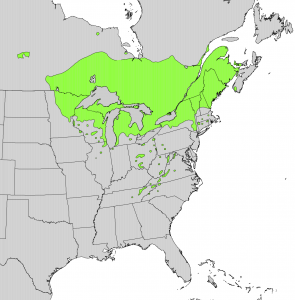 The range of eastern white cedar extends from Canada’s boreal forest biome south into the Great Lakes-St. Lawrence ecozone of Ontario and Quebec. (Range map from "Atlas of United States Trees" U.S. Geological Survey digitized by Elbert L. Little, Jr.). The congeneric (same genus) species, western red cedar, Thuja plicata, occurs in British Columbia. Eastern white cedar does not grow nearly as tall as western red cedar.
The range of eastern white cedar extends from Canada’s boreal forest biome south into the Great Lakes-St. Lawrence ecozone of Ontario and Quebec. (Range map from "Atlas of United States Trees" U.S. Geological Survey digitized by Elbert L. Little, Jr.). The congeneric (same genus) species, western red cedar, Thuja plicata, occurs in British Columbia. Eastern white cedar does not grow nearly as tall as western red cedar.
White cedar grows in a wide range of habitats, from swamps to dry areas. In the winter white cedar stands provide important cover for white-tailed deer which “yard” or crowd into them. The snow is not as deep in these stands of trees, and the deer feed on the cedar branches.
 White cedar can be very slow growing, and can survive in stressful habitats such as limestone cliff face nooks and crannies. Botany professor, Doug Larson, now retired from Guelph University, studied white cedars along the Niagara Escarpment. He and his students found that some of these scraggly looking trees were 400 years old (Kelly and Larson 1999). Doug's 2007 book with Peter Kelly, The Last Stand: A Journey Through the Ancient Cliff-Face Forest of the Niagara Escarpment is all about this previously unrecognized unique forest ecosystem.
White cedar can be very slow growing, and can survive in stressful habitats such as limestone cliff face nooks and crannies. Botany professor, Doug Larson, now retired from Guelph University, studied white cedars along the Niagara Escarpment. He and his students found that some of these scraggly looking trees were 400 years old (Kelly and Larson 1999). Doug's 2007 book with Peter Kelly, The Last Stand: A Journey Through the Ancient Cliff-Face Forest of the Niagara Escarpment is all about this previously unrecognized unique forest ecosystem.
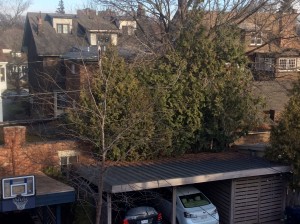 On a more pedestrian note, white cedar is a popular hedging plant. Unsuspecting homeowners plant small cedar trees in cute little hedges, which, when untended, grow into Canadian versions of the too-tall, out-of-control British hedge.
On a more pedestrian note, white cedar is a popular hedging plant. Unsuspecting homeowners plant small cedar trees in cute little hedges, which, when untended, grow into Canadian versions of the too-tall, out-of-control British hedge.
White cedar wood is brittle, so isn't used much for indoor furniture. But, the wood is durable and rot-resistant, so the trunks are commonly used for split rail fences, roofing shingles, and also, for outdoor furniture.
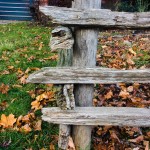 Cedar-lined closets are popular in many Canadian homes, where they are used to protect clothes from moths. However, the research into the effectiveness of cedar-lined trunks and closets suggests that the any benefits have less to do with toxic cedar volatiles protecting your textiles, and more to do with the sealed unit, into which one places moth-free textiles! If you’re already battling clothes moths, you will have more luck with buying a chest freezer for clothes storage, since it will actually kill the moth life stages.
Cedar-lined closets are popular in many Canadian homes, where they are used to protect clothes from moths. However, the research into the effectiveness of cedar-lined trunks and closets suggests that the any benefits have less to do with toxic cedar volatiles protecting your textiles, and more to do with the sealed unit, into which one places moth-free textiles! If you’re already battling clothes moths, you will have more luck with buying a chest freezer for clothes storage, since it will actually kill the moth life stages.

Eastern white cedar goes well with retro walls and guitars in Grateful Head Hairdressers (photo credit: Christopher Smith)
So, there you have it: eastern white cedar, a plant of great cultural and historic significance for Canada's First Nations and European colonists, with relevance in the trendiest places. It's truly evergreen.
References:
Kelly, P.E. and Larson, D.W. 2000. An Ecological Assessment of the Long-Term Survival of Ancient Populations of Eastern White Cedars on Cliff Faces of the Niagara Escarpment. pp 275-281 in Pollock-Ellwand et al. eds. Proceedings of the Parks Research Forum of Ontario AGM 22-23 April1999. PRFO, University of Waterloo, Ontario, Canada.
http://casiopa.mediamouse.ca/wp-content/uploads/2010/05/PRFO-1999-Proceedings-p275-281-Kelly-and-Larson.pdf
Kelly, P.E. and Larson, D.W. 2007. The Last Stand: A Journey Through the Ancient Cliff-Face Forest of the Niagara Escarpment. Dundurn Press, Toronto, Ontario, Canada.
Paper, J.D. 2007. Native North American Religious Traditions: Dancing for Life. Praeger Publishers. Westport CT USA.
Advent Botany 2015 post 3: Anyone can grow paperwhites -- this post is still in draft form as of December 3 2015
Paperwhite bulbs are a species of Narcissus which includes daffodils.Narcissus papyraceus is native to the mediterranean, but are naturalized in other regions with mediterranean climates, such as California. They're very popular Christmas flowers, along with Amaryllis and Poinsettia, in Canada, and bulbs available for forcing are easily grown on gravel, in the same way that hyacinths and snowdrop bulbs are grown in bulb vases. -- add in photo of a bulb vase here.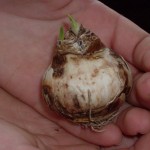
Paperwhites have a wonderful, strong fragrance.
This is the bit where I link to the research that Alastair told me about.
Advent Botany 2015 post 4: How do you create a Candy Cane Chrysanthemum? -- this post has been bumped to 2016 Advent Botany, to make room for a young botanist to write a 2015 Advent Botany guest blog for Alastair and Jonathan at Reading University
Peppermint candy canes are the North America equivalent of rock. They are ubiquitous during the holiday season in North America, showing up every where -- on Christmas trees, in hot chocolate and as gift decorations.
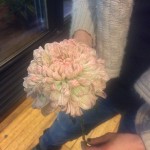 In recent years, a novelty Chrysanthemum flower, has appeared. It has green and red stripes running through a white flower. I wanted to include it in the Advent Botany series, because it's a bit crazy and is a manufactured appearance that recalls a simple plant sciences experiment that many people would have done as a child. This is my Ladybird book about plants dating back to the 1960s: Plants and how they grow. It definitely inspired me to become a scientist and a plant ecologist!
In recent years, a novelty Chrysanthemum flower, has appeared. It has green and red stripes running through a white flower. I wanted to include it in the Advent Botany series, because it's a bit crazy and is a manufactured appearance that recalls a simple plant sciences experiment that many people would have done as a child. This is my Ladybird book about plants dating back to the 1960s: Plants and how they grow. It definitely inspired me to become a scientist and a plant ecologist!
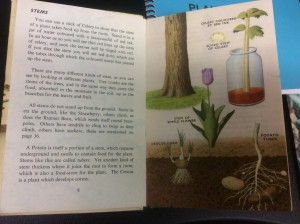 I'm leaving this post in draft form to show how it looks on December 3 2015, when I received the email telling me that I didn't need to supply the Advent Botany series with 4 posts (I breathed a sigh of relief). You can see it in the 2016 series.
I'm leaving this post in draft form to show how it looks on December 3 2015, when I received the email telling me that I didn't need to supply the Advent Botany series with 4 posts (I breathed a sigh of relief). You can see it in the 2016 series.

